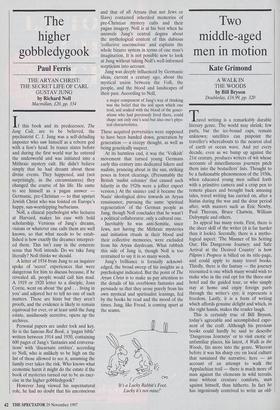The higher gobbledygook
Paul Ferris
THE ARYAN CHRIST: THE SECRET LIFE OF CARL GUSTAV JUNG by Richard Noll Macmillan, £20, pp. 334 If this book and its predecessor, The Jung Cult, are to be believed, the psychiatrist C. J. Jung was a self-deluding imposter who saw himself as a reborn god with a lion's head. In trance states before and during the first world war he entered the underworld and was initiated into a Mithraic mystery cult, He didn't believe simply that he had dreamt about these divine events. They happened, and (not surprisingly, in the circumstances) they changed the course of his life. He came to see himself as a pagan answer Germanic, pre-Christian — to that upstart Jewish Christ who was foisted on Europe's happy, sun-worshipping barbarians.
Noll, a clinical psychologist who lectures at Harvard, makes his case with bold scholarship. Versions of Jung's dreams, visions or whatever one calls them are well known, so that what needs to be estab- lished is how exactly the dreamer interpret- ed them. This isn't easy in the concrete sense that Noll intends. Do we take Jung literally? Noll thinks we should.
A letter of 1934 from Jung to an inquirer spoke of 'secret' experiences that were dangerous for him to discuss because, if he revealed all, people would call him mad. A 1919 or 1920 letter to a disciple, Joan Corrie, went on about 'the god . . . living in you' and adjured her to tell no one of such matters. These are hints but they aren't proofs, and the evidence is likely to remain equivocal for ever, or at least until the Jung estate, assiduously secretive, opens up the archives.
Personal papers are under lock and key. So is the famous Red Book, a 'pagan bible' written between 1914 and 1930, containing 600 pages of Jung's 'fantasies and conversa- tions' with 'cliscarnate entities', according to Noll, who is unlikely to be high on the list of those allowed to see it, assuming the family ever takes the risk. Who knows what economic harm it might do the estate if the book of mysteries turned out to be an exer- cise in the higher gobbledygook?
However Jung viewed his supernatural role, he had no doubt that his unconscious and that of all Aryans (but not Jews or Slays) contained inherited memories of pre-Christian mystery cults and their pagan imagery. Noll is at his best when he unravels Jung's central dogma about the mythological content of this dubious `collective unconscious' and explains the whole bizarre system in terms of one man's imagination. It is not possible now to look at Jung without taking Noll's well-informed scepticism into account.
Jung was deeply influenced by Germanic ideas, current a century ago, about the mystical union between the Volk, the people, and the blood and landscapes of their past. According to Noll,
a major component of Jung's way of thinking was the belief that the soil upon which one trod, soil soaked with the blood of the gener- ations who had previously lived there, could shape not only one's soul but also one's phys- ical characteristics.
These acquired perversities were supposed to have been handed down, generation by generation — a creepy thought, as well as being genetically suspect.
At its harmless end, it was the `Volkish' movement that turned young Germans early this century into dedicated hikers and nudists, prancing about in the sun, striking poses in forest clearings. (Presumably the British 'nudist colonies' that caused such hilarity in the 1920s were a jollier export version.) At the sinister end it became the Nazis' ideological drive towards an Aryan renaissance, pursuing the same 'spiritual regeneration' of the German people as Jung, though Noll concludes that he wasn't a political collaborator, only a cultural one.
Inevitably he was anti-Semitic, since Jews, not having the Mithraic mysteries and initiation rituals in their blood and their collective memories, were excluded from his Aryan daydream. What rubbish this side of Jung is, though Noll is too restrained to say it in so many words.
Jung's brilliance is formally acknowl- edged, the broad sweep of his insights as a psychologist indicated. But the point of The Aryan Christ is to make us pay attention to the details of his overblown fantasies and persuade us that they arose purely from his own mystical and spiritualist leanings, fed by the books he read and the mood of the times. Jung, like Freud, is coming apart at the seams.
Its a Lucky Rabbit's Foot. Lucky its not mine!'


















































































 Previous page
Previous page